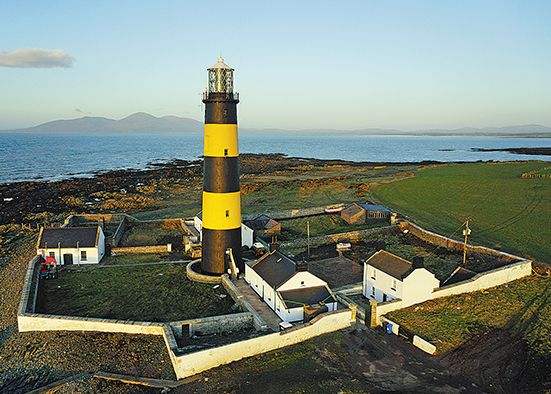Plans to replace mercury energy lamp with LED blub
Plans to replace mercury energy lamp with LED blub
15 January 2025

THE Commissioner of Irish Lights has lodged a formal application for a controversial plan to downgrade the iconic sweeping beam at St John’s Point lighthouse.
The listed building consent application was lodged on December 16 with Newry, Mourne and Down planners just a month after a public information event was held in Newcastle to provide local people with an opportunity to express their views on the proposal.
Campaigners opposed to changes at the lighthouse want local politicians, who have insisted there must be no change at St John’s Point and previously unanimously endorsed a motion to this effect, to double down on their decision.
The Dublin-based Commissioner (CIL) is seeking approval to reduce the scale of the lighthouse beam and replace a mercury bath – on which the lighthouse’s giant Fresnel lamp rotates – with a rotating ball bearing mechanism.
Billed as an “engineering upgrade”, CIL insists the work, which includes replacing a 1000 watt high energy lamp with a 90 watt LED bulb, is necessary with the emphasis on improving the reliable and safe operation of the lighthouse for the mariner.
In addition, the organisation said the existing high energy lamp will soon become unavailable due to energy efficiency regulation changes which will make it impossible to source.
The organisation says the planned programme of work is necessary to ensure the “safe and reliable operation” of an aid to navigation in a sustainable way.
CIL insists the proposed work will retain the rotating Fresnel lens and unique flash character of the light, with the St John’s Point proposal
similar to projects which have already been completed at Tory Island, Rathlin West and Rathlin East lighthouses.
CIL is planning to reduce the range of the light down to 18 miles, retain the existing auxiliary light with a LED equivalent, provide full emergency lanterns and remove an existing diesel generator and its fuel source and provide a battery back up.
There are also plans to remove the existing wall lining to expose the original masonry on the lighthouse tower, with the work aimed at reducing cost and maintenance requirements.
The planned investment also aims to “provide opportunities for realising the tourism potential of the site” with the work taking place if listed building consent is secured.
With much focus on the Fresnel lens and the bearing system on which it rotates on a bath of mercury, CIL has described the lens as an “exceptional work of engineering”.
But it says current UK regulations require organisations to put processes in place to protect human health and the environment from the adverse effects of mercury, including phasing out of its use where alternatives are available.
Removing
“Irish Lights and other Lighthouse Authorities are in the process of removing mercury from their lighthouses and from an aid to navigation perspective, there are many alternative light sources available,” says CIL.
“However, from a heritage perspective, Irish Lights has developed a system that will allow retention of the historic lens, while still delivering the required safety and environmental benefits.”
CIL says the mechanical bearing it is proposing has been successfully installed and is in operation at a number of Irish Lights sites. The lens is rotated on a ball bearing race using a specially designed brushless motor.
It says the design is in use on a number of other onshore lighthouses with Fresnel lenses where mains electricity is available.
Ahead of November’s public information event, CIL said there are many other heritage features at St John’s Point including houses, gasometers and fog signal engines and it looked forward to working with the local community and Northern Ireland state agencies to determine how best to protect the lighthouse and its heritage into the future.
Lecale Lightkeepers, the campaign group which wants the current beam, historic Fresnel lens and rotating mechanism retained and utilised as an important element of living history, not solely a navigational aid, for generations to come.
It is vehemently opposed to CIL’s plans with campaigners arguing any attempt to replace the rotating beam with a less effective LED light must be revisited.
Campaigners are appealing to the council not to renege on its support for the battle to protect the historic light in its present mechanism.
They contend that fitting LEDs at other lighthouses has not been successful and dismissed CIL claims that the mercury bath at the Killough lighthouse poses a health risk, labelling them a “red herring”.
The Lecale Lightkeepers hope the application for listed building consent is refused, warning that if it’s approved, it will bring about a “material change” at the lighthouse.
A group spokeswoman said: “We want the council to double down on its support for retaining the beam and not back away from it.
“While CIL is proposing to retain the Fresnel lens, it plans to remove its equally historic Bourdelles rotation system because of its unjustified claim about the toxic danger of mercury in this equipment.”
The spokeswoman added: “The current light produces an iconic and characteristic ‘loom’ or halo around the beam, which enables it to be seen over the horizon which is not readily seen with an LED which has a shorter range.
“The intrinsic character of the lighthouse is its historic sweeping beam which meets the required standard and must not be altered, nor diminished. While we understand the need to modernise, we draw the line at the destruction of the sweeping beam that the lighthouse produces.”


